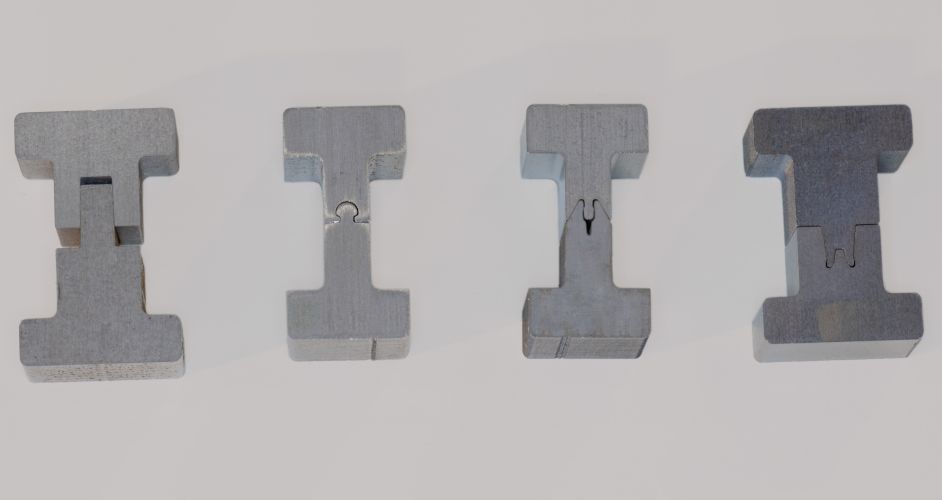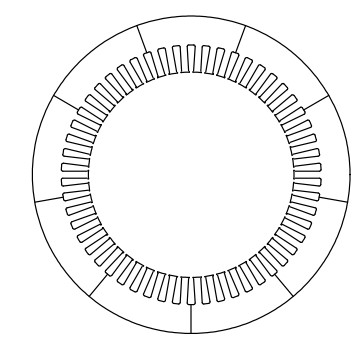Electromobility is on its way. The momentum is increasing and the migration from the combustion engine to hybrid and fully electric models has begun. Major changes are about to take place, not only in the vehicles themselves, but also in the value chains. Electromobility is having an enormous impact on the entire industrial production of machinery, systems, and components. Entire industries are being transformed, redefined, or replaced. It is a good idea to explore new concepts and technologies for the production of electric drives in electric vehicles.

Fig. 1: Traditional strip layout

Fig. 2: Segments, coupling variants

Fig. 3: Stator stack and segments

Fig. 4: Segments – strip layout SWD AG
When it comes to big changes, the past has taught us that linear concepts, i.e. those that simply extrapolate the past into the future, are bound to fail. Broadly established technologies are often not efficient enough or not scalable. It is therefore advisable to look into the future and anticipate which megatrends will determine the production of electric drives for electric vehicles. To this end, it is worth understanding the principles of today’s combustion engine production and taking them into consideration. In addition, Industry 4.0 technologies are opening up new opportunities in manufacturing technology in general. Topics such as data analysis, the derivation of trends, and artificial intelligence are leading to improvements in production efficiency and even self-optimizing systems.
Today’s electric motor consists of a stator made of stamped and stacked electrical sheets, a paper or plastic insulation between the electrical lamination stack, and the copper coils that form the coils. The coils are interconnected depending on the type of drive. The rotor is often also made of stamped lamination stacks that are stacked and equipped with permanent magnets or copper rods / cast aluminum / cast copper. The stator and rotor are held in position by a housing and bearing plates and protected against environmental influences. In conventional production, both the stator and the rotor are punched from the same electrical sheet in order to save material (Fig. 1 – Traditional strip layout). What is still considered a small amount of waste material for electric motors (material utilization of approx. 50%) would simply be unthinkable in the production of combustion engines and will continue to be unacceptable for electric motors in the future. On the one hand, the logistical challenge in the supply of materials is enormous, and on the other hand, cost efficiency is not guaranteed. In addition, the requirements placed on the electrical sheet for stator and rotor are completely different, which means that different materials will be used. A completely separate view of stator and rotor is unavoidable, resulting in maximum material efficiency. Another important aspect is the scalability of production processes. Subprocesses that are as simple and efficient as possible, which can be multiplied and scaled by multiplication, can be better controlled and – just as importantly – they reduce downtime. Capital efficiency is increased significantly.
Segmentation of the stator is already used in the production of electric drives for electric vehicles. The stator and rotor are no longer punched from one electrical sheet strip, but are produced separately. This means that the ideal material can be used for the stator and processed with maximum material utilization. Topics such as optimizing magnetic properties and increasing iron and/or copper fill levels can be implemented profitably. If the segments are manufactured with high precision and fitted with a corresponding coupling (Fig. 2 – Coupling variants), very narrow tolerances are possible. In the process, the function of the housing can be rethought, as we will see later. Segments, however, not only contain single tooth segments, but also multiple segments, as used in asynchronous motors (Fig. 3 and 4– segmented stator and multi-segment strip layout).
Interested?
Then send us a non-binding inquiry and we will get back to you as soon as possible.
The rotor is made of material that is ideally suited to its operating points. The strength, due to the high centrifugal forces, and the magnetic properties are the primary aspects. Depending on the type of motor, the rotor is equipped with permanent magnets or it is cast or routed with aluminum or copper. Issues such as outgassing and gap formation are critical during casting, which has corresponding consequences for the choice and coating of materials. Electrical sheet with insulating varnish coating is not an ideal starting point. If the rotor is viewed completely separately, the optimum material can be selected and processed very efficiently. If we take the segmentation of the stator one step further and use full-surface bonding of the laminations instead of the current punch-stacking process, further benefits and optimizations will emerge. Bonding varnish (Backlack) as a full-surface bonding enables the production of high-strength and precise stator segments that can be easily processed further (e.g. insulated and wound) and assembled into a stator. Depending on the design of the coupling (Fig. 2), individual segments can again be perfectly joined into a stator. Even stators with roundnesses of a few 1/100 mm are feasible. We are thus moving away from traditional manufacturing processes, in which individual sheets are formed into stator stacks using punch-stacked nubs or welded seams, towards laminated precision parts. Precision not only encompasses the contour of the individual laminations, but also the length of the lamination stacks in the future. Taking a step further, these precision parts are suitable for fulfilling additional functions. They can, for example, partially replace the function of the housing. The laminated precision parts are suitable for mounting the bearing plates directly, thus reducing the tolerance chain, which can allow for smaller air gaps. The integration of cooling is also conceivable, whereby the housing would only play a subordinate role.
This means that new manufacturing solutions are required that can be used with maximum process reliability. One of these solutions is the BPS® system from SWD AG for the fully automated production of bonded stator segments. The system produces precise, laminated stator segments from electrical sheet and includes the punching of the laminations and their stacking and bonding to create the high-precision, laminated stator segment. Depending on the application, further process steps such as attaching end caps and insulating paper, winding with copper, or joining the segments to the full circle stator are also possible. The tooling concepts are highly innovative, novel solutions both in the areas of punching as well as stacking and bonding. New materials in toolmaking enable maximum service life and the simple replacement of tools are important aspects. Traditional know-how in punching and toolmaking is not required; the machine monitors itself and the system operator simply follows the instructions. The production data is automatically recorded, analyzed, archived, and used to optimize the system itself. Even the continuous monitoring of quality by the operator is recorded in the system and continuously evaluated. The result is a complete production solution for laminated precision segments, which is operated on site in the production of electric drives. In other words, a concept from the production of today’s combustion engines: The factory within the factory, which eliminates logistics.
This technology and solution is not in the development phase, but is already in use today in series production. Narrow strip electrical sheet is punched in two tracks, without straightening to maintain the magnetic properties, at over 800 h/min. The wedge shape is equalized automatically and it is possible to process the edge strip. This punching technology is a joint development with Schuler. The bonding varnish (Backlack), an epoxy coating, reacts chemically in just a few minutes to form high-strength, high-precision laminated stator segments. Even the length can be controlled, which further simplifies downstream processes and opens up new potential. The company GF – Georg Fischer – broke new ground when it came to high-precision bonding tools made of special materials. Solutions have been developed for the high-precision eroding of special materials in lengths of up to 300 mm. Segmentation can be used in any way, be it single teeth, which are already being produced and installed in large-scale series today, or multiplesegments for stators with a high number of slots or asynchronous motors. Segments from a few mm in length to approx. 250 mm in length can be manufactured, again with completely new tooling concepts based on new materials and new manufacturing solutions. The possible applications are almost unlimited.
Together with Industry 4.0 solutions, electromobility is leading to far-reaching changes at all stages of manufacturing in the automotive industry. New technologies and solutions are already available and are constantly being further developed. Anyone who wants to be on the front line in the future is well advised to align the current principles of combustion engine production (minimal material consumption, optimized production for every component, factory-in-factory production) with the technologies and options for the production of electric drives and to drive these optimizations forward.
SWD AG Stator- und Rotortechnik is the partner for your next generation of electric motors. As a technology leader, we work with you to develop lamination stacks that give your motors a decisive competitive edge. We accompany you from the initial idea to efficient series manufacturing and take over production at every stage.
Interested?
Then send us a non-binding inquiry and we will get back to you as soon as possible.
Facts
- Bonding varnish (Backlack) enables the production of high-strength and precise stator segments
- Stators with roundnesses of several 1/100 mm are feasible
- Segmentation can be used in any way
- Segments from a few mm in length to approx. 250 mm in length can be produced